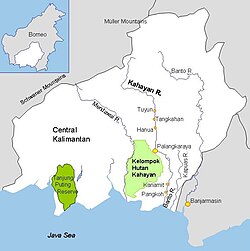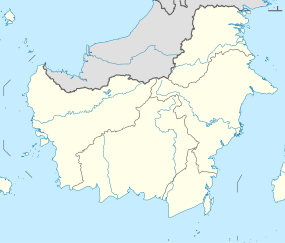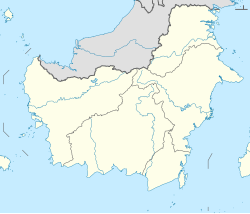Barito River
| Barito River Sungai Barito, Sungai Dusun, Soengai Doesoen, Sungi Banjer, Sungi Dunsun, Soengai Baritoe, Sungai Banjar, Sungai Banjarmasin, Sungai Banjar Besar | |
|---|---|
 Barito and other rivers in Central and South Kalimantan | |
 Location of river mouth | |
| Location | |
| Country | Indonesia |
| Physical characteristics | |
| Source | |
| • location | Müller Mountain Range |
| Mouth | |
• location | Java Sea |
• elevation | 0 m (0 ft) |
| Length | 890 kilometers (550 miles) |
| Basin size | 70,000 km2 (27,000 sq mi) |
| Discharge | |
| • average | 3,706–4,514 m3/s (130,900–159,400 cu ft/s) |
| Basin features | |
| Tributaries | |
| • left | Mangkatip, Negara River, Martapura River |
| • right | Murung River, Anjir Tamban, Anjir Serapat, Kapuas River (Barito River tributary)[1] |


Barito River is an 890-kilometer-long (550 mi) river with a drainage basin of 70,000 square kilometers (27,000 sq mi) in South Kalimantan, Indonesia. It originates in the Muller Mountain Range, from where it flows southward into the Java Sea. Its most important affluent is the Martapura River, and it passes through the city of Banjarmasin.[2][3][4]
This river is the location of the closest relative of the Malagasy language of Madagascar, the Ma'anyan language of Dayaks, from where settlers arrived in Madagascar (presumably in waves) from the 3rd to 10th century and from which the current island nation's population largely traces its origins.
Geography[]
The river flows in the southeast area of Borneo with predominantly tropical rainforest climate (designated as Af in the Köppen-Geiger climate classification).[5] The annual average temperature in the area is 24 °C (75 °F). The warmest month is October, when the average temperature is around 26 °C (79 °F), and the coldest is January, at 20 °C (68 °F).[6] The average annual rainfall is 2,735 millimeters (107.7 inches). The wettest month is December, with an average of 437-millimeter (17.2 in) rainfall, and the driest is September, with a 62-millimeter (2.4 in) rainfall.[7]
Images[]

Dutch boat on the Barito River (1917)

Inhabitants along the Barito

A boat on the Barito
See also[]
References[]
- ^ "Archived copy". Archived from the original on 16 May 2017. Retrieved 8 January 2019.CS1 maint: archived copy as title (link)
- ^ van Hoëvell, Wolter Robert (1838). Tijdschrift voor Nederlandsch Indië (in Dutch). 1. Ter Lands-drukkerij. p. 6.
- ^ Buddingh, Steven Adriaan (1861). Neêrlands-Oost-Indië: Reizen over Java, Madura, Makasser, Saleijer, Bima, Menado, Sangier-eilanden, Talau-eilanden, Ternate, Batjan, Gilolo en omliggende eilanden, Banda-eilanden, Amboina, Haroekoe, Saparoea, Noussalaut, Zuidkust van Ceram, Boeroe, Boano, Banka, Palembang, Riouw, Benkoelen, Sumatra's West-Kust, Floris, Timor, Rotty, Borneo's West-Kust, en Borneo's Zuid- en Oost-Kust; gedaan gedurende het tijdvak van 1852-1857 (in Dutch). M. Wijt. pp. 442.
de groote Banjersche rivier (de Barito).
- ^ Nederlandsch-Indië (1838). "Tijdschrift voor Nederlandsch-Indië" (in Dutch). 1–2. Lands-drukk.: 6. Cite journal requires
|journal=(help) - ^ Peel, M C; Finlayson, B L; McMahon, T A (2007). "Updated world map of the Köppen-Geiger climate classification". Hydrology and Earth System Sciences. 11 (5): 1633–1644. doi:10.5194/hess-11-1633-2007. Retrieved 30 January 2016.
- ^ "NASA Earth Observations Data Set Index". NASA. 30 January 2016.
- ^ "NASA Earth Observations: Rainfall (1 month - TRMM)". NASA/Tropical Rainfall Monitoring Mission. 30 January 2016.
External links[]
 Media related to Barito River at Wikimedia Commons
Media related to Barito River at Wikimedia Commons
Coordinates: 3°22′32″S 114°14′13″E / 3.37556°S 114.23694°E
- Landforms of South Kalimantan
- Rivers of South Kalimantan
- Rivers of Central Kalimantan
- Rivers of Indonesia




